| History of Dish & Tank film developing equipment |
|
|
|
| Some Patent information relating to early designs of roll film (and later 35mm) developing tanks, can be read here. | |
|
Wikipedia tells us that the first flexible photographic roll film was sold by George Eastman in 1885, but this original "film" was actually a coating on a paper base. As part of the processing, the image-bearing layer was stripped from the paper and attached to a sheet of hardened clear gelatin. In 1888 the name "Kodak" was born and the KODAK camera was placed on the market, with the slogan, "You press the button - we do the rest." This was the birth of 'snapshot' photography, as was the term applied to what, at the time, seemed a less serious form of photography. Roll film made possible photography by the masses. The first transparent plastic roll film followed in 1889. It was made from highly flammable nitrocellulose ("celluloid"), now usually called "nitrate film". Although cellulose acetate or "safety film" was introduced by Kodak in 1908, at first it found only a few special applications as an alternative to the hazardous nitrate film, which had the advantages of being considerably tougher, slightly more transparent, and cheaper. The changeover to cellulose acetate film base wasn't completed until 1950 (1951 for 16mm cine film). Roll films enabled a massive improvement in picture taking convenience compared to the use of large, heavy and fragile, glass plates but required fresh thinking on how best to process them. Glass plates were processed individually in trays by the light of a red sagfelight, given that early light sensitive emusions were limited in their spectral sensitivity. But long roll films, with a tendency to curl up into their roll format unless held by some means, couldn't just be placed in the bottom of a developing tray. Besides, the film needed to be kept from curling up so that developer could evenly access all the surface. Professional darkrooms solved the problem by using deep tanks and kept the film uncurled by attaching both ends to separated supports, or by just attaching one end to a support and using a weight at the other end to keep the film supported vertically. The earliest use of roll film was within Kodak No.1 and No.2 box cameras which took either (the No.1) a hundred round photographs with a diameter of 2½ inches (65 mm) or (the No.2) sixty photographs with a diameter of 3½ inches (89mm). These films would have been very long, 20 feet (6m) or more, so couldn't be developed by other than professional means. However, by the early 20th century new film formats became available that were shorter and raised the prospect of home developing, or even developing between stops when partaking of long holidays or overseas exploration. The 'See-Saw' Method |
|
 |
By taking advantage of bright red safelighting suited to orthochromatic emulsions, roll films could be manually 'see-sawed' up and down through developer in a shallow dish, and subsequently through other dishes containing the stop bath and then the fixer. This technique was still advised in the 1950s for those wishing to 'have a go' at processing (orthochromatic) films at home, without the added expense of buying a developing tank. Photax sold (mid-1950s and quite probably earlier) a simple Developing Trough (right), consisting of a deep, curved base developing tray, with a trapped roller. |
 |
| By feeding the film under the roller, a user could have reasonable assurance that his film would stay correctly immersed within the developer throughout the developing process, even with minimal safe-lighting. Thus, with care, the Photax developing trough made possible the see-saw dish developing of even panchromatic film. | ||
|
E.Leitz introduced an arrangement in 1925 for developing lengths of 35mm film to compliment the introduction of their Leica cameras. Mark Osterman has sent the picture shown to the right. He says: "I am currently doing research on the earliest 35 mm film camera introduced by Leica in 1925. I am a photo process historian (formerly from the George Eastman Museum 1999-2020) and will be making the original film to shoot in a 1928 Leica A camera and process it with original 1920s equipment". "Film in this era was only sensitive to blue and violet allowing it to be developed by inspection" (using a bright red safelight). |
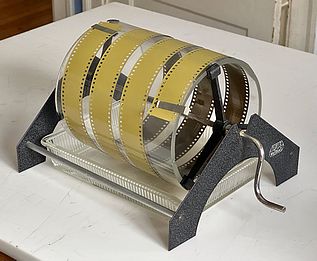 |
|
| As can be seen, the film is wrapped around the central rotatable cylinder, emulsion-side out. The whole apparatus is positioned above a developing tray and the lower surface of the cylinder carries the film through the developer with each turn of the handle. When development is deemed to be complete, the developing dish can be swapped for other, similar, dishes containing stop-bath and finally fixer. |
 |
|
|
Granitine 'Trident'
Developing Tray The device is the Granitine
Developing Tray with Trident Roll Film Weight. It was made in
white porcelain by Taylor, Tunnicliffe & Co of Stoke-On-Trent,
England at the beginning of the 20th Century. |
.jpg) |
.jpg) |
| The film would have been looped under the central 'finger' of the Trident, with its sensitive emulsion to the outside of the finger's curve, so that the emulsion would not have been damaged by abrasion while the film was pulled back & forth in reasonably firm contact with the central finger. | ||
| 1912
Designs in the Houghton Ltd catalogue Similar contrivances to the above were on sale within the Houghton Ltd catalogue of 1912, see illustration below, left. But also notice that, at the same date, Houghton were selling a 'Standa' daylight developing tank arrangement. Seemingly the film was placed into a detachable spool box and wound from that into the developing chamber in conjunction with an 'apron', meaning a flexible length of clear film-like material (probably celluloid) with small projections on its edges so that when the photographic film was wound within it, the photographic film was touched only by the apron projections and the film emulsion could be fully accessed by the processing solutions. My thanks to Richard W Holzman for these Houghton adverts and also for the Kodak Developing Machine information, further below. |
|
 |
 The 'Standa' tank probably owes its origins to the Kodak ideas shown immediately below. Like the Kodak tanks it makes use of a flexible, ribbed, 'apron' into which the film is coiled for developing without the emulsion surface being covered by adjacent coils. The 'Standa' holds the exposed film within a separate side chamber and has means by which the film is pulled from the side chamber and wrapped within the 'apron' within a 'coiling chamber'. The side chamber is then detached and the film, wound within the apron, transfered (in daylight, due to the design of the coiling chamber) to a separate developing tank. |
|
Kodak Developing Machine,
1902 This device may be the earliest form of developing tank and is surprisingly sophisticated considering the year that it was first sold. Richard W Holzman has provided me with a pdf file scanned from the British Journal of Photography (BJP), 26th September 1902, that reviews this item and describes its method of operation. Richard has also sent a April 1903 issue of 'Camera Craft', which gives an over-view of this item. Both include the illustration right. It made use of a flexible, edge-ribbed, 'apron' to coil the film for developing without the emulsion surface being covered by adjacent coils. This 'apron' also formed a light tight 'shroud' around the film, so that the lid of the 'Machine' could be removed, preferably in artificial light, to enable to developer to be poured out and fixer poured in. Although the relevant British Patent has not yet been traced, this link downloads the French version from 18th September 1902, published 8th May 1903. |
|
|
Gavin Ritchie explains the
procedure for using the 1902 Developing Machine:
|
|
|
Kodak Daylight Film
Developing Tanks There are three basic components, the (wooden) film winding box, the stainless-steel tank and the flanged end 'drum'. The wooden box was a loading system for the drum – the film was wound onto the drum simultaneously with a flexible red/black light proof 'apron'; much as with the 1902 Developing Machine, above. After the loading operation, the film, coiled around the drum within the apron, and held by a clip to prevent it uncoiling, was transferred to the tank. During transfer of the film to the metal developing tank, it was protected from light by the red/black light proof apron. Thus, with some care to transfer the film in subdued lighting, no darkroom was required. Thus, the first five steps for using the 1902 Developing Macine (as above), similarly applied with this design of tank. Subsequently the film was transferred to its metal processing tank where the developer and subsequently the fixer would be introduced. |
|
|
|
Kodak made several of these Developing Tanks of different sizes. A 1914 Canadian Kodak Co. booklet from 1914 describes the ones available at that time, their operation and prices. Sizes were the 'Brownie' (2¼ inch); the Vest Pocket (1.625 inch); 2½ inch; 3½ inch; 5 inch and 7 inch. Also described are the Brownie Developing Box and Brownie Developing Box Outfit, see below. It can be viewed as a pdf by clicking the link, here. The two tanks shown below are further items within Gavin Ritchie's collection. The first image is of a tank sized for Vest Pocket film, a title derived from the small cameras which used such film, though it was subsequently known as 127 roll film. The cardboard box holds the wooden box as well as the nickel-plated tank. |
 (Ref: date on inside cover of the Sept. 1924 instruction booklet) |
|
|
|
||
| The tank shown below is a Kodak Film Tank for larger format films. The nickel-plated tank is embossed with a 'C'. | ||
|
|
||
|
Brownie Developing
Box It relates to a device for
simplifying the construction, and reducing the cost, of a developing
tank by avoiding the need for a) an apron, b) a 'drum' to hold
the coiled film and apron, and c) a separate tank in which to
carry out the developing. The Developing Apparatus relied upon
a light-tight elongated tray, half the length of the exposed
film, into which the film was inserted, still on its spool. With
the tray cover closed and developer already poured in, an externally
actuated arrangement pulled the film from the spool so that the
film formed a shallow horizontal 'V' shape within the tray, each
leg of the 'V' being half of the film length. External agitation,
perhaps by rocking, brought the film into contact with the developer
so that processing could take place. Kodak also sold a Brownie Developing Box Outfit, consisting of a Brownie box camera, a Developing Box in its own cardboard box, a measuring Beaker, Chemicals, three Trays, a Printing Frame and Instruction Book, all in a Wooden Box with a Brownie character on the top. One example is shown below, right. This one has a No.1 Brownie Model B box camera, but at least one similar outfit was made, containing a No.2 Brownie box camera (see the 1914 Canadian Kodak Co. booklet). Another Patent sent by Gavin Ritchie seems to be for a more advanced, albeit contemporary, design, where the film is extended within the Developing Box using a winding handle rather than a pull cord. The US Patent, No.917078, was filed on 3rd November 1906 and was granted on 6th April 1909. It is in the name of Robert Kroedel, an employee of Eaastman Kodak to whom the patent Rights were assigned. |
||
 |
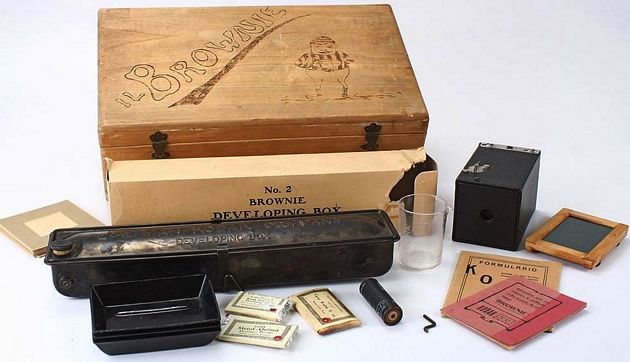 |
|
 |
||
| It should be noted that in all the above early Kodak developing arrangements it was expected that the black backing paper, protecting the film itself from light, would be immersed within the processing solutions at the same time as the film. | ||
 |
The 'Correx' apron
loading tank The illustration is taken from 'Amateur Photography', edited by Anthony Johnstone, 7th edition (revised) 1951. Loading the apron type of tank was quite easy, but with the disadvantage of it being a rather a messy business when the time came to remove the processed film from the wet apron. Also, the wet apron took a long time to dry because water could get trapped within the edge dimples. At the darkroom loading stage you had to take special care to prevent the apron collecting dirt from the floor as it was wound into contact with the film, especially if developing a 35mm film, where the apron would be a similar length to the film (around 1.6m) and might drag on the floor. On the other hand, spiral groove
tanks could give trouble in loading by the 'push-in' method,
when the film might stick before being fully inserted (especially
if the spiral groove retained dampness from previous use) and
hence the reason for the assisted loading arrangements provided
by Paterson and others from the early 1950s see |
|
| The problems of safely 'handling' a long length of film during development were magnified in the 1930s, when the Leica & Contax cameras (and increasingly many others) introduced the concept of using lengths of 35mm motion picture film stock for 'still' photography. The film lengths were too long for see-saw dish developing (a standard 36exp 35mm film is over 5ft long, around 1.6m). Fine grain developers, as required by miniature negatives, also introduced softer working developers with longer film processing times, making manual see-saw dish development tedious. So, together with increased film speeds and panchromatic emulsions, the latter preventing the use of red safelights, a new approach was required to (home) film development. | ||
| However, despite the relative impracticality of see-sawing processing 35mm film, at least one manufacturer tried to persist with equipment designed for this technique. The economical 'DIMPLE' developing dish was sold for the purpose, maybe 1946. A full pdf of the instruction sheet can be downloaded here. Its method of use is illustrated below. | ||
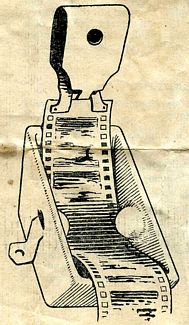 |
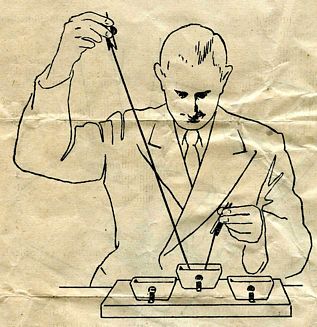 |
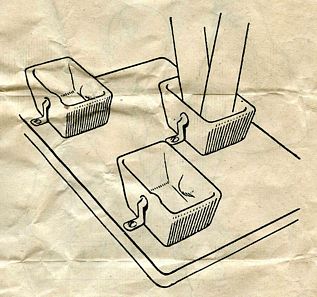 |
|
|
Each 'Dimple' dish measures some 95mm long (top length) by 50mm wide by 35mm deep (internally). The dish is made of white, glazed, ceramic. The 'dimples' which give the device its name, serve two purposes. Their main use is to form protrusions inside the dish from each side, and so provide a reduced width channel which traps the film while it is see-sawed back and forth. Their second use, as shown in the picture (right, above), is to enable the dish to be anchored down to a wooden board by means of 'S' bracket 'clips' (though these may not have been supplied with the dish(es) and may have been something a user had to improvise). This information is courtesy of Brian Rees. Another, perhaps more practical, idea was for the 35mm film to be wrapped (emulsion side out) around the outside of a horizontal glass drum. The underside of the drum was suspended horizontally within a developer dish such that the underside of the drum, together with the film, dipped into the developer and other processing solutions. |
|
| ILFORD Developing Tank | ||
|
One of the earliest spiral loading developing tanks on the British market must have been this one, as sold by Ilford before WW2, possibly 1938. It was supplied in a thick-sided cardboard box, some 150mm x 150mm x 115mm deep. The box lid shows the paddle steamer trade mark (below) which is the 1925-1945 version of the several shown on the Ilford chronology Introduction web page. 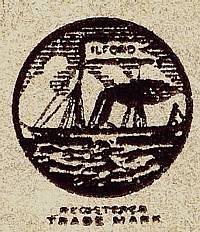 |
|
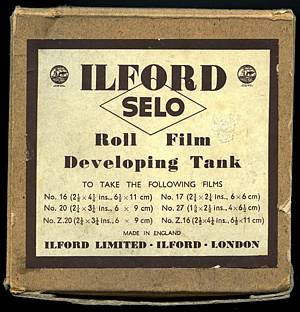 The Ilford Developing Tank box lid, showing the four different film sizes it accepts, viz: (116 & 616; 117; 120 & 620; 127) but since No.17 and 20 roll films are both 6cm wide, the tank only requires three reel to reel width separation 'notches' (6cm for the above, 4cm for 127 and 6.5cm for 116 & 616). Notice, there is no facility for 35mm. |
|
Paul Godfrey suggests that the tank was probably made by British Xylonite Plastics Ltd, known as B.X. Plastics Ltd in 1938 and which set up a jointly owned company with Ilford Ltd in 1946, called Bexford Ltd., to manufacture cellulose acetate film base (see my chronology 'slot' for 1946). Paul says "When I was in business as a photographer in the late 1960s and early 1970s, I used to get a regular visit from the Ilford "rep.", Alan Mitchell. Alan is mentioned as a source in Andy Holliman’s book 'The Cameras of Ilford Ltd'. In about 1970 I had built a water jacket to control the temperature of three 3 gallon Kodak tanks that I was using to process Agfacolor paper. The tanks I was using had come from East Anglia Colour Laboratories of Caister near Great Yarmouth. In addition there was an extra one branded Ilford. I had shown the Ilford tank to Alan Mitchell on one of his visits and he told me how British Xylonite had made them. I remember the Ilford tank was narrower than a Kodak one and would not accept any of the various stainless steel racks that Kodak made, though would, of course, have taken any of the Ilford racks". The tank lid is clearly marked "ILFORD Ltd" and "British Made" (see below - Britain was a major manufacturing nation pre-WW2 and the population were proud to purchase British made products, believing them to be superior to many foreign equivalents). |
||
| My thanks to David Muggleton for loaning me this tank so that I could photograph it and upload these pictures. |
|
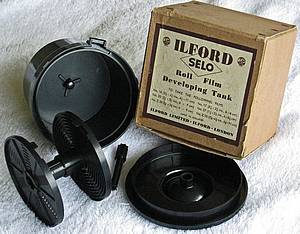 |
| ILFORD Developing Tank in 1949 | ||
 |
The advertisement to the left is taken from the back page of Amateur Photographer magazine for August 24th 1949. The whole page advert was devoted to Ilford Photographic Accessories, including a darkroom safelight, a dial-type thermometer, a 'Seconds' timer and the Ilford Exposure Meter Model C. Notice that this 1949 Ilford developing tank looks near identical to the pre-WW2 tank (above), but the text no longer mentions size 117 film. The tank would probably still accept 117 as it is the same film width as No.20 (620/120) roll films (2¼" = 57.2mm), but 117 was most likely a redundant film size by 1949. What the 1949 tank is capable of accepting, is 35mm, which was becoming a standard film format by this time, though few amateurs, apart from the wealthy, would have been using 35mm in 1949. Perhaps Ilford wished to cater for their own 35mm cameras, the Advocate and the Ilford Witness. The latter was expected to soon be in the shops in 1949, though in fact it didn't appear for another two or three years. |
|
|
The Gnome Developing
Tank I owned a Gnome Universal tank such as this in the late 1950s, when my local chemist sold me an old one he still had in stock when I couldn't afford one of the more modern designs e.g. by Johnsons, Nebro and Paterson. The only real disadvantage was that the Gnome Universal took a lot of developer and fixer solution because it was sized to accomodate a full 36 exposure 35mm film. I was only using 127, and later 120, roll film, so the volume of solutions required made it less economic than a smaller tank sized for roll film and 20 exposure 35mm. |
 |
|
To read more about spiral loading developing tanks for darkroom use, as sold by Paterson, Johnsons of Hendon and others from the late 1940s, see my web page here. To read about the Envoy plate developing tank, for size 2½" x 3½" plates, see here. For tanks that could be loaded without the need for a darkroom, called Daylight Loading Tanks, read on. |
||
| Darkroom
& Daylight Loading Developing Tanks, by Ernest Pless For the following historical information regarding the daylight tank loading manufacturer Ernest Pless, I must thank Richard W Holzman. Ernest Pless of Vienna, Austria, was born on 24th December 1891, and set up his company in 1919 manufacturing plastic, metalwork, optical and electronic items. His first photographic accessories appeared in the early-mid 1930s, one of the first being a small visual exposure meter named the Leudi of which there were about a dozen variations, with two shown below, left and centre. None of the Pless accessories bore the Pless name but (apart from the Leudi) had 'Plex' within their product title. Other Pless products were a rangefinder, also trademarked 'Plex' (see below, right), and a 35mm slide projector, branded a 'Plex 50'. |
||
.jpg) Nebro offered the Lite version of the Leudi from 1955 to at least 1964, presumably made by Pless although there is no clue on the meter. During WW2 it was made in the USA and sold by the Mimosa American Corp. starting in 1940 continuing with models until at least 1955. |
.jpg) The Leudi Model II, as sold by Johnsons of Hendon sometime in the 1960s. This is believed to be the last visual type meter sold. Since Ernst Pless died 1960, one wonders who designed the Model II. |
|
|
'Plex 50' 35mm slide projector. The vertical dome seems to be a light trapped ventilation tube. |
|
To the left is shown a 35mm slide projector also branded 'Plex', as can be same from the nameplate above. The lens is also branded Plex Wien (Vienna, Austria) |
|
Ernest Pless died on 24th June 1960, but his son, Ernest jnr. (1916-1988) was a co-founder of AKG in 1947 with Dr. Rudolf Görike in Vienna, Austria. They "became a giant with microphones and headphones" (ref: Richard W Holzman). They also made two models of exposure meter in the mid-1950s. AKG Acoustics is currently an acoustics engineering and manufacturing company, a subsidiary of Harman International Industries, of Harman Kardon fame, a division of Samsung Electronics. Early Developing Tank Patents On 16th March 1941, Mimosa American Corporation, seemingly the US Agents for the Pless patent No.2,112,6067, filed against the Elkay Photo Products Company of Newark, New Jersey, for infringing on patent No.2,112,606, especially with regard to the US produced Elkay developing tank, incorporating a developing spiral with facility to accommodate various widths of film format. But this complaint was dismissed on 17th March 1942 by reference to three previous patents filed by (individually) Drew, Feigleman and Kelsay. These all included means of varying the width of their developing spool (not distinguishing whether the spool was of the spiral loading or apron type). The Drew patent No.1,807,901 was issued on 2nd June 1931, the Feigelman patent. No.1,618,402 was issued on 9th December 1924 and the Kelsay patent No.1,212,498 was issued as early as 16th January 1917. The Drew patent seems to be
one of the earliest GB patents relating to spiral loading developing
tanks, No.GB320,716 with an Application Date of 20th
August 1928 and a final completion date of 24th October 1929.
It was filed by Clayton Lyman Drew, a citizen of the United States
of America, of 582, Market Street San Francisco, California,
USA. This patent chronologically precedes the Drew patent in
the above infringement case but still mentions the possibility
of means to adjust the width of the developing reel. In the Drew
patent, the reel is of the spiral centre-loading type where the
film is attached to the centre of the spiral and is wound into
the spiral grooves from the centre outwards. Such a design requires
the film to be momentarily bent lengthwise as it is loaded, so
as to reduce the film width and allow it to 'spring' into the
central spiral groove. Therafter, it is wound into the groove
of the spiral, much as with a spiral that loads from the outside,
but starting from the centre. But earlier developing tank
patents exist. As already described above within the Kodak section,
are patents from 1902 and 1909. These are for 'apron' loading tanks. |
||
| Richard W Holzman has supplied several advertisements, beginning in 1936, that illustrate the Pless range of tanks, both daylight loading and darkroom loading. The daylight loading variants usually have 'Super' added at the beginning of their names e.g. SuperPlex | ||
 p639 of the 1936 BJPA, advertising the SuperPlex and SuperKino daylight loading tanks and the Perplex and Perkino darkroom loading tanks. |
 p675 of the 1938 BJPA, advertising the Super-Junoplex, Simplex and SuperKino daylight loading tanks and Perplex and Perkino darkroom loading tanks. |
|
 p653 of the 1937 BJPA, advertising the SuperPlex, SuperKino, Simplex and Super-Junoplex daylight loading tanks and Perplex, Perkino and Junoplex darkroom loading tanks. |
||
| Referring
to the daylight loading tanks, the SuperKino took 35mm film,
the Simplex took 120/620 roll film, the Super-Junoplex took 127
roll film, while the SuperPlex was a Universal tank suited to
127, 120/620 & 116/616 roll films. The exposed film was placed
in the tank's side chamber and means was provided by which the
film could then be wound onto a grooved spiral within the main
tank body, while the tank and photographer remained in daylight. For more information on the Simplex tank, click here. For more information on the SuperPlex tank, click here. |
||
|
Daylight loading designs were comparatively expensive. In 1938, the roll film Simplex was priced at £1.12s.6d (£1.63p) see advert above. This was roughly twice as much as an equivalent daylight loading tank at that time. Compared to 2020 purchasing power, the Simplex would now cost about £75 on a simple Retail Price Index (inflationary) comparison. Ernest Pless, the Vienna manufacturer of the above tank range, still manufactured and exported to the UK after the War. A US advertisement, sent by Richard W Holzman, taken from the 1949 December issue of Popular Photography (p164), is shown below, left. In the UK, it seems Photax (London) Ltd. became the distributors. The illustration, below right, is from a November 1952 issue of Amateur Photographer magazine. As shown in the 1952 Photax
advert, there was a 35mm Daylight Loading tank available, which
Photax advertised using the name SuperFlex. But there seems to
be an error in this advertisement name since, even in Photax's
own advert, the name on the lid of the 'SuperFlex' can be seen
to read 'Super Plex'. The 1952 daylight loading Super
Plex seems the equivalent of the earlier Superkino (see BJPA
adverts, above). The difference is that the Post-WW2 Super Plex
incorporated a 'cutter' to cut off exposed lengths of 35mm film,
leaving the unexposed portion still in the cassette for later
use. The Uniplex darkroom loading tank incorporated automatic up-and-down movement of the spiral during development by the simple expedient of shaped projections on the underside of the centre column of the spiral acting as cams to lift and drop the spiral as it rotated during agitation. This idea, or similar, became near universally applied around this time. However, even for Ernest Pless, this wasn't a new idea; the Kino darkroom loading tank for 35mm film had this arrangement when tested by 'The Miniature Camera Magazine' in October 1937. |
||
 |
 |
|
| Below are further illustrations of Ernest Pless developing tanks, copied to me by Richard W Holzman. These are all darkroom loading tanks. | ||
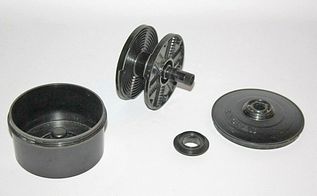 The Kinoplex |
 The Miniplex 16 |
.jpg) The Perkino |
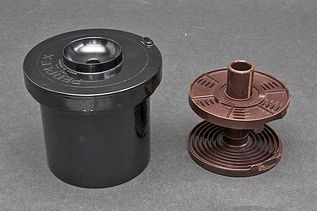 The Perplex |
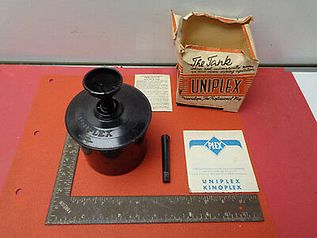 The Uniplex |
|
| Tribox Darkroom Loading Tank Although not (knowingly) manufactured by Ernest Pless, the novel Tribox darkroom loading tank, as shown below, was also made in Austria. |
||
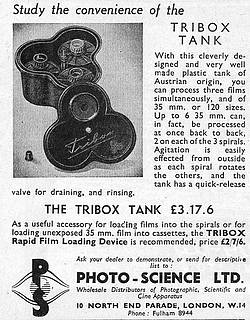 |
The primary claim relates to it being a method for developing a small number of films all together, but with the facility to give each film individual attention and to limit each one's developing time according to the nature of the film, exposure or subject. This isn't so conveniently possible when using a tank where several spirals are placed one above the other on a common central column. The Tribox, on the other hand, is a horizontal design with three spirals linked by a central geared spindle, such that all three spirals rotate for agitation via a single agitation rod, though agitation is not dependent upon all three of the spirals being in position within the tank. The Tribox equipment was designed for processing a mixed batch of 35mm miniature and 120 format roll films, whilst enabling each film to be treated on an individual basis, if desired. Large commercial tanks could provide for individual timings, but such tanks were impractical for small user needs. The B.J. Almanac for 1952 describes the use of the TriBox. |
|
|
It emptied through a novel valve in the bottom, controlled by a spring-loaded shaft. A single nut served to lock both the valve and the tank lid. The 'Tribox' advert (above) claims that up to six 35mm films can be processed 'back to back', two on each of the three spirals. As can be seen, the price in September 1952 was £3.17s.6d (£3.88). The B.J.Almanac for 1953, pp256-257, illustrates and describes accessories sold for use with the TriBox. These were a rapid loader for assisting winding films onto their spiral, price £2.7s.6d (£2.38p), an electrically powered agitator (called a mixer), price £18, and a triple set of open topped, light alloy constructed, tanks, arranged as the TriBox, for accomodating one or more of the spirals when removed from the TriBox ahead of the others, enabling their fixing and washing to commence. |
||
| Daylight Loading Developing Tanks, sold by Johnsons of Hendon and Neville Brown | ||||
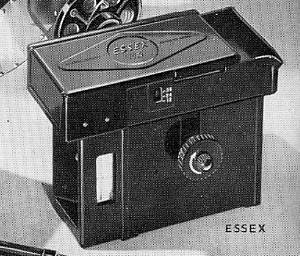
|
The Essex and Kent-20 Dayight Loading developing tanks were sold in the early 1950s by Johnsons of Hendon and Neville Brown & Co Ltd (Nebro). They were based upon the pre-WW2 Agfa Rondinax 35 U and 60 tanks and may have been manufactured by Agfa for UK distribution by Johnsons and Nebro. Below are some images of contemporary Agfa Rondinax 35U and Rondinax 60 tanks (the latter courtesy of Brian Rees who also loaned me the Rondinax 35U to photograph). These pictures can be understood by being viewed in conjunction with the Agfa instruction booklets (Rondinax 60 here and Rondinax 35U here). My thanks to Richard Urmonas for making these instruction booklets available. His website can be viewed at: http://www.urmonas.net/index.html Brian Rees has donated (July 2014) what seems to be a version of the original Rondinax 35 U instructions, unfortunately missing its front and back covers. Click here to download it as a pdf. |
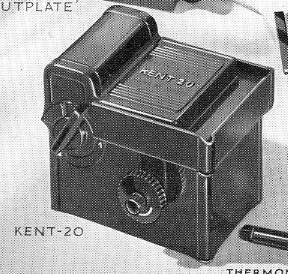
|
||
|
|
|
 |
 |
 |
 |
 |
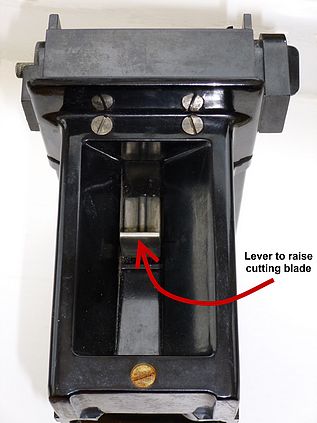 |
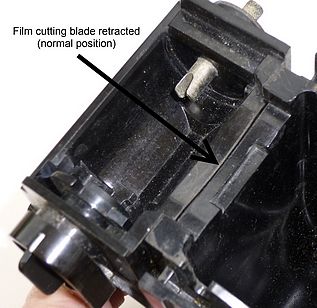 |
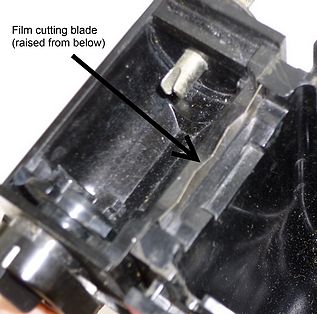 |
|
|
|
.jpg) |
.jpg) |
|
|
||
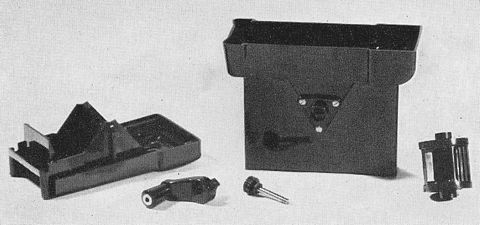
|
 |
|
|
Rondix 35 It is not often that one comes across something entirely new in the way of developing tanks, for most of them follow the well tried spiral groove method. The new Agfa Rondix 35, which we saw first at Photo Kina 1956 is now on sale in this country and is a most interesting device. At first glance, and from the outside, it looks rather like the well-known Rondinax 35, but it is appreciably smaller and works on quite a different principle. Let us explain first of all what it aims to do and how it does it. The Rondix is a completely daylight developing tank designed for the ordinary velvet light-trapped 35mm film cassettes, both loading and processing taking place in full light, no darkroom being required. The tank, which takes only 6½oz. of solution, has a receptacle at one end which takes the cassette. As soon as the film in the cassette has been fully exposed in the camera it is wound back into the cassette, but with a little of the tongue still projecting from the light-trap. This projecting tongue is pulled out so that not more than 3cm of the full width of the film projects from the cassette and the tongue itself is cut off square. When we remove the lid on the Rondix, unscrew the handle from the side and pull out the spindle, we find we can remove a small central bobbin l¼ins in diameter, which has a spring clip to which the perforations of the end of the film can be attached. The cassette, with its projecting film attached to the bobbin, is now dropped into the tank, the spindle reinserted and the light tight lid replaced. The developer is now poured into the tank and the handle slowly turned at the rate of one-half revolution per second until resistance is felt, which means we have come to the end of the film. Immediately the crank is turned in the reverse direction but now at a higher speed, i.e. 1 to l½ revolutions per second, and this speed must be maintained throughout the rest of the processing. Whenever a check is felt the turning is once more reversed, this turning backwards and forwards being continued, as we have indicated, until the developing time is up, after which the developer is poured out, rinse water poured in, followed by fixing. At the end of the fixing period the film should be completely removed from the tank and washed separately. The novelty about this tank is the actual method of passing the film through the solution. Unlike other tanks, there is no plastic spiral and all that happens when you start turning is that the film is wound on to the small central bobbin, most of which is below the level of the developer. The film is completely wound on to this central bobbin with all the turns touching just as they are in the dry cassette, the film so to speak taking developer with it into its coil. However, as soon as the whole film is wound on we reverse the turning, and this unwinds the film loosely inside until we come to the attached end, whereupon it is once more wound on to the bobbin, but this time with the emulsion side inwards. Then, again when we reach the end, we loosen it once more, wind on with the emulsion outwards and so on backwards and forwards, until the end of the time. In this way a constant supply of fresh developer is provided for the whole surface and careful examination of our test film showed that development was completely uniform, with no sign of surface injury or scratching. The only precautions to be taken are to see that the handle is kept moving all the time. The Rondix 35 tank is designed, as we have said, for the velvet light-trap cassettes in which manufacturers sell their films. It is necessary to point out that these cassettes cannot be used again because the developer tends to splash into the light-trap of the cassette, and so it must be thrown away after use. Nor will the tank take the metal self-opening cassettes such as those supplied for the Leica and Contax and other Zeiss Ikon cameras, or the Shirley-Wellard. The simplicity of the design of this tank enables it to be sold at £2.12s.6d (£2.63p) which is less than half the cost of the Rondinax 35. This latter, however, has advantages over the Rondix in that it will take any of the cassettes, velvet light-trap or self-opening and, if desired, the ordinary velvet light-trap cassettes can be used again, although we do not recommend such a procedure. |
||
|
|
|
|
|
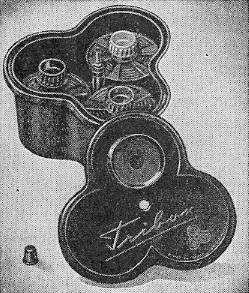 The
TriBox tank design was patented by Helmuth von Stwolinski of
Hotel Noppinger, Salzburg, 1-Maxglan, Austria. It was patented
in Austria on 25th November 1946. The
The
TriBox tank design was patented by Helmuth von Stwolinski of
Hotel Noppinger, Salzburg, 1-Maxglan, Austria. It was patented
in Austria on 25th November 1946. The